(Ghent 1794 - Rome 1856)
Young Roman woman at prayer, with a sleeping child, surrounded by a monk and a little girl.
Second quarter of the 19th century.
Oil on canvas.
H. 50 ; l. 41 cm.
(19 ³/₄ x 16 ¹/₈ inches)
In a church, a woman in Italian costume is holding an infant in her arms. She seems to be looking up at the altar while a monk and a young girl are praying behind her. The perspective of the painting is opened up by the rich décor of the church in the background, despite the tight framing of the figures. The shining oil lamp in the foreground completes the setting, while the delicate expression of the young Roman woman and the soft brushstrokes lend the painting a gentle, melancholy atmosphere.
Unlike François-Joseph Navez (1788 - 1869), who went to Rome but stayed for only four years, a handful of contemporary Belgian painters chose to settle there permanently. These include the Antwerp-born Martin Verstappen (1773 - 1852) and the Ghent-born Jean-Baptiste-Louis Maes. While the former found his niche in landscape painting, the latter established himself in the mid-1820s as one of the most sought-after painters in Rome in the popular genre of the Italian scene.
A pupil at the Academy of Fine Arts in Ghent, Jean-Baptiste-Louis Maes showed precocious talent[1]. He won prizes in the competitions he took part in at the art schools in Mechelen (1810), Ghent (1817), Brussels (1818), Antwerp and Amsterdam (1819). Elected a member of the Royal Society of Fine Arts of Ghent in 1820, he was granted an annual pension by his native city for two years in order to continue his training abroad. From Paris, where he stayed with the landscape painter François Vervloet (1795 - 1872), he competed successfully for the Prix de Rome at the Antwerp Academy in 1821. With a subsidy from the Dutch government, he quickly set off for the Eternal City with Vervloet. Leaving Paris in mid-August 1821, the two artists arrived at their destination on 16 September.
When he entered Rome, Jean-Baptiste-Louis Maes was an established artist who had already distinguished himself in various genres: history, allegory and portraiture. New commissions came in from his home town, including a large altarpiece: The Holy Family with Saint Anne and Saint Joachim for the church of Saint-Michel (in situ).
These signs of interest in his painting enthused the painter, who still aspired to be a history painter: "I have just learned with great satisfaction that the church of St. Michel [in Ghent] has just commissioned me to paint a picture for the chapel of St. Anne. "2] On 30 June 1824, he wrote to Liévin De Bast, the secretary of the Royal Society of Fine Arts in Ghent, "I am now happy to find the opportunity to devote myself entirely to the historical genre, and I shall endeavour to do so with honour to the general expectation of the public and my fellow citizens: here I am content and happy, always finding myself in the midst of masterpieces.
Along with a small group of Belgian-Dutch compatriots, the aforementioned Vervloet and Verstappen, Hendrik Voogd (1768 - 1839), Cornelis Kruseman (1797 - 1857), Philippe Van Bree (1786 - 1871), and the sculptor Mathieu Kessels (1784 - 1836), Maes made excursions into the Roman countryside, visiting the Alban Hills, Castel Gondolfo, Genzano, Nemi, Palestrina, Zargalo, Fracati and Grottaferrata, places renowned for the beauty of their village women and their colourful, shimmering costumes. He also frequented more cosmopolitan circles. In July 1823, for example, he found himself at the convent of Santa Scolastica in Subiaco, in the company of Vervloet, the mysterious Russian Abasettel, the Frenchmen Louis Étienne Watelet (1780 - 1866), Raymond Quinsac Monvoisin (1790 - 1870) and François Antoine Léon Fleury (1804 - 1858). Finally, he rubbed shoulders with Germanic artists.
Stimulated by his colleagues and by the special atmosphere of the Eternal City, he turned increasingly to the genre that was then in fashion: the Italian scene. In a letter to Lièvin de Bast dated 30 June 1824, he wrote: "I have the honour of announcing to you that I have just sent three paintings at the beginning of this month, representing a St Sebastian, an old woman in prayer, and the third the Pifferari in front of a Madonna: at the beginning of next month I will send another, the subject of which is a young and beautiful Vignerola with an old man, a group of natural size". These paintings were included in the Ghent Salon of 1824.
In 1827, in Rome, he married Anna Maria, daughter of the engraver Bartolomeo Canini. From then on, he would add his wife's name to his own. They had a son in 1828, Giacomo, a painter like himself. Maes-Canini also remained a useful intermediary for Belgian-Dutch artists arriving and staying in Rome.
With the exception of a few religious paintings, such as The Good Samaritan of 1825 (fig. 2), which he sent to Belgium, Maes-Canini now devoted himself solely to Italian scenes, becoming one of Rome's specialists in this genre. He was so successful that, in 1834, he ran a workshop in which he employed several young artists, including his son, in order to fulfil his many commissions. Gifted with an unquestionable mastery of drawing and the technique of modelling through skilful lighting effects, he delighted in pandering to the tastes of the Eternal City's cosmopolitan clientele with somewhat saucy depictions of the picturesque Roman people. Some of his works are reminiscent, in a gentle way, of the paintings by Léopold Robert (La-Chaux-de-Fonds 1794 - Venice 1835) (fig. 7), with whom he was undoubtedly related, as Denis Coekelberghs suggests.4 He painted pilgrims, hermits, shepherds, contadini, pifferari and, finally, young, seductive Roman women.
The latter was his favourite theme. Under his brushes, they usually appear in three-quarter view, sometimes in bust form (fig. 3). He sometimes depicted them undressed (fig.6), most often in their traditional colourful costumes. They are grooming themselves, preparing for the annual carnival on the Corso (figs. 5 & 8), filling a lamp with oil (fig. 4) and so on. Sometimes they appear alone, sometimes accompanied by an older maid, which brings out the freshness and delicacy of their youth. Through the tight framing of the compositions around the figures and the intensity of the chiaroscuro, some of Maes-Canini's paintings offer a suave variation on the Roman neo-Caravaggio of the second quarter of the 19th century (fig. 8).
The young Roman woman at prayer.
Some of his paintings were successful. Such is the case of The Young Roman Woman at Prayer. The work analysed here is one of several variants of the same painting, depicting a young Roman woman in Frascati costume, praying in a church before a pious image. The image is not depicted in the paintings, but is subtly suggested, notably by the copper lamp hanging in front of the altars, as is the case with many examples in Rome.
The artist took two approaches to the subject. The first shows the young woman alone, her hands clasped and her elbows resting on an altar beside a bouquet of flowers (figs. 9, 12 & 13). One example bears the date 1845.
The second variant of the subject is known to us from several paintings. This time, the young Roman woman is holding a sleeping child in swaddling clothes (figs. 10 & 11). One of them also bears the date 1845.
The special feature of our version is that the young Roman woman is surrounded in her prayer by a pilgrim monk and a little girl. An interesting detail. The girl has turned her face away and seems to be attracted by an event taking place in the church.
The decor of these different versions is more or less the same. Between antique columns, we see the vast apse of a church choir with walls decorated with mosaics and murals, while in the middle of the choir stands a marble ciborium.
It should be noted that Maes-Canini exhibited a Young Roman Woman at Prayer at the Brussels Salon in 1833, and that a copy of the painting Young Roman Woman at Prayer with a Bouquet of Flowers, erroneously signed Jean Portaels (Vilvorde 1818 - Brussels 1895), exists in the Musée des Beaux-Arts in Charleroi (inv. 574). This copy is further proof of the success of Maes-Canini's painting.
The painting studied here is more ambitious than the other known versions of the subject. It is a fine example of the painting of Jean-Baptiste-Louis Maes-Canini. Along with Navez, Van Bree and Louis Ricquier (1792-1884), he was one of the main Belgian representatives of the Italian-style genre scene of the second quarter of the nineteenth century, treated in the romantic, sentimental, poetic and idealistic style typical of the northern schools, to which the Russian Karl Bryulov (1799-1852) also belonged, who died in Rome, the Danes Ernst Meyer (1797-1861) who died in Rome, Albert Küchler (1803-1886), the Czech Leopold Pollak (1806- 1880) who died in Rome, and the Germans August Riedel (1799 - 1883) who died in Rome, Adolf Henning (1809-1900), Johann Heinrich Richter (1803-1845), and Theodor Leopold Weller (1802-1880).
Alain Jacobs, 2024.
We would like to thank Alain Jacobs for writing this note and helping us to identify this work.
Illustrations :
Fig. 2 J.-B.-L. Maes-Canini, The Good Samaritan, Rome 1825, oil on canvas, 251 w 200 cm, Amsterdam, Rijksmuseum, inv. SK-A-1078.
Fig. 3 J.-B.-L. Maes-Canini, Portrait of a Young Italian Girl, Rome 1828, 47 x 37 cm, Ghent, Bijlokemuseum, inv. A65.02.029.
Fig. 4 J.B.L. Maes-Canini, Young Italian Woman with Oil Lamp, 1835, oil on canvas. Current location unknown.
Fig. 5: J.B.L. Maes-Canini, Young Italian girl preparing for Carnival, 1838, oil on canvas, present location unknown.
fig. 6. J.B.L. Maes-Canini, Jeune Italienne à sa toilette, 1839, oil on canvas, 99 x 74.5 cm. Present location unknown.
fig. 7. J.B.L. Maes-Canini, Young Italian Woman Preparing for Carnival, 1854, oil on canvas, 74.6 x 99 cm. Current location unknown.
Fig. 8 J.B.L. Maes-Canini, Young Italian Girl Preparing for Carnival, 1855, oil on canvas, 100x200cm. Current location unknown.
fig. 9: J.B.L. Maes-Canini, Young Italian Girl Pirating, 1845, oil on canvas, 30 x 23.8 cm. Present location unknown.
Fig. 10: J.B.L. Maes-Canini, Young Italian Woman at Prayer, Holding a Child, 1837, oil on canvas, 99 x 74 cm. Berlin, Museum Berggruen, Alte und Neue Nationalgalerie
fig. 11: J.B.L. Maes-Canini, Young Italian Woman at Prayer, Holding a Sick Child, 1845, oil on canvas, 30 x 23.8 cm. Current location unknown.
fig. 12: J.B.L. Maes-Canini, Young Italian Woman Pirating, n.d. (?), oil on canvas, 90 x 72 cm. Present location unknown.
fig. 13 J.B.L. Maes-Canini, Young Italian Girl Pirating, n.d., oil on canvas, 79 x 64 cm. Present location unknown.
References
[1] On J.B.L. Maes-Canini, see primarily L. De Bast,
[2] Annales du Salon de Gand et de l'école moderne des Pays-Bas, Ghent, with P.F. De Goesin-Verhaeghe, 1823, pp. 135-136; D. Coekelberghs, Les peintres belges à Rome de 1700 à 1830, Bruxelles-Rome, Institut historique belge de Rome, III, 1976, pp. 404-406, and A. Jacobs & P. Loze, in cat. expo. 1770-1830. Autour du Néoclassicisme en Belgique, Ixelles, Musée Communal, 1985/86, p. 243-245 &433.
This is The Holy Family with Saint Anne and Saint Joachim, 1827, oil on canvas, 285 x 215 cm, Ghent, Saint Michael's Church.
[3] Amsterdam, Rijksmuseum, inv. RP-D-2017-888.


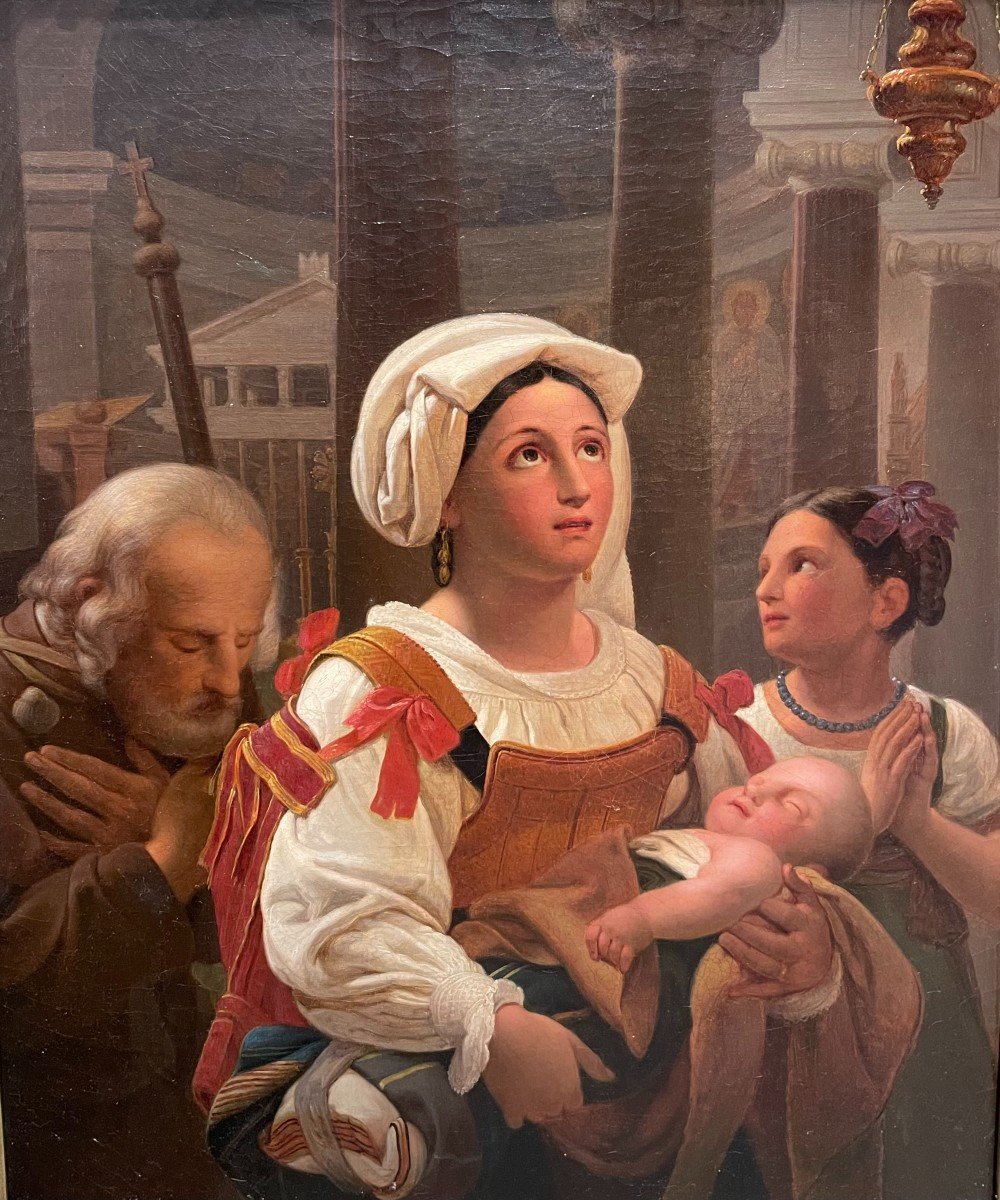





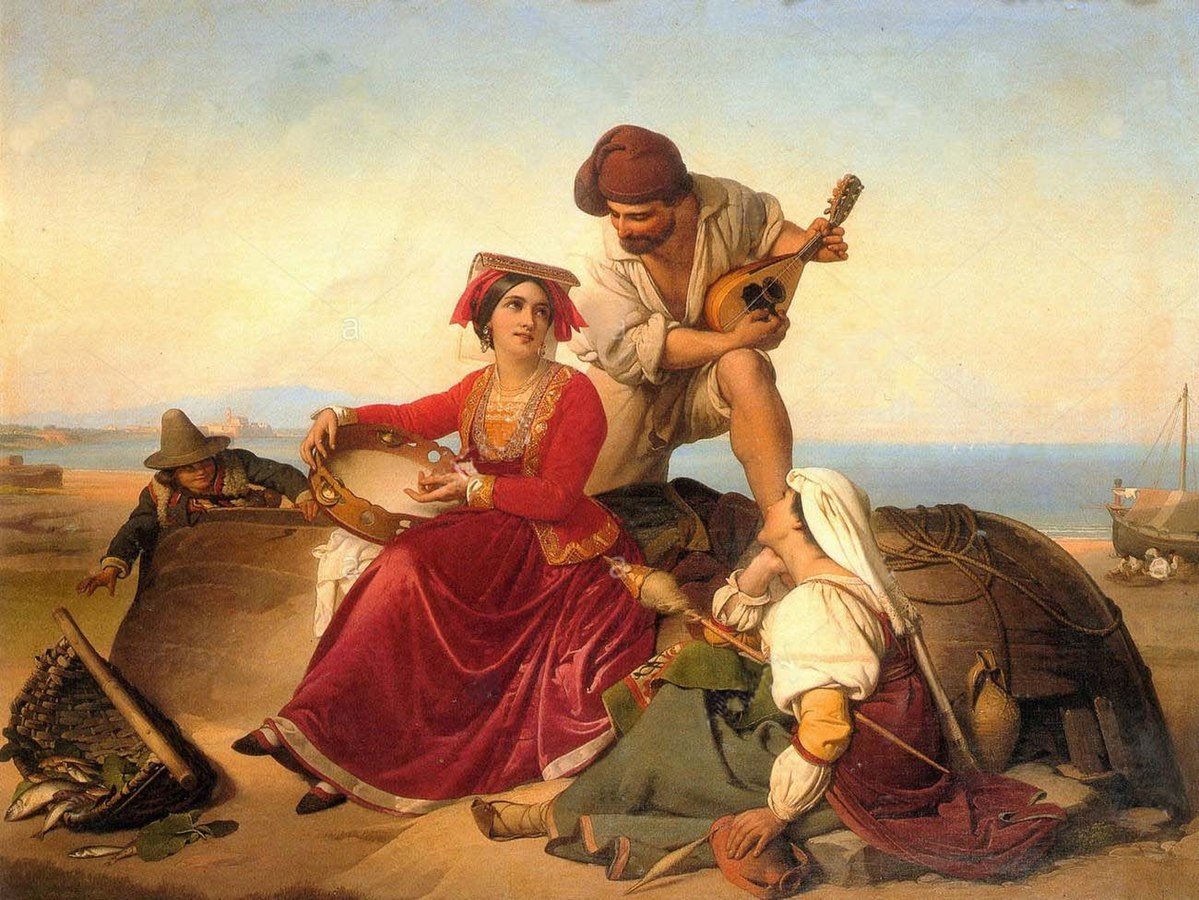



















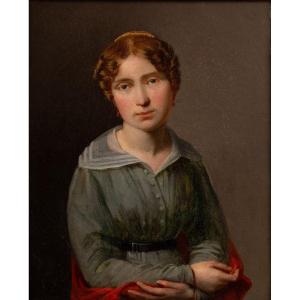




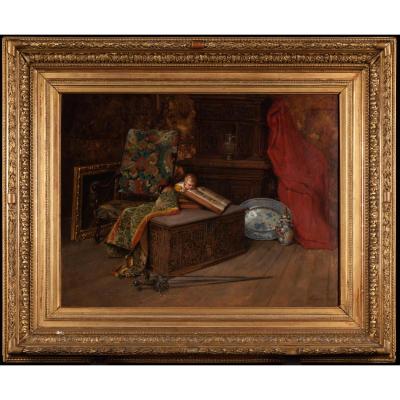

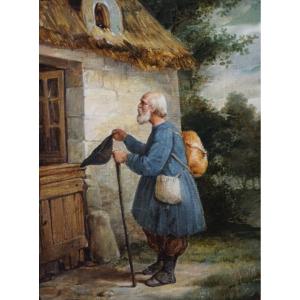




 Le Magazine de PROANTIC
Le Magazine de PROANTIC TRÉSORS Magazine
TRÉSORS Magazine Rivista Artiquariato
Rivista Artiquariato